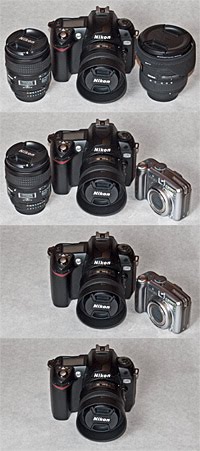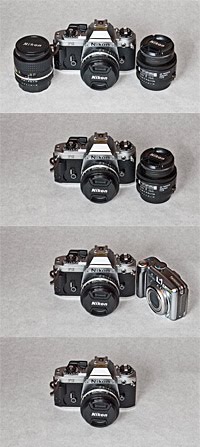Determining the right photographic equipment to bring when traveling can be a painful balancing act. Bring too much and you will not only hurt you back and miss a lot of shots as you juggle lenses, but will no doubt be subjected to the unapproving gaze of your spouse. Bring too little and you are constantly haunted by the shot 'that might have been' had you only had the perfect lens, filter, body, flash, etc.

Nikon D70
Nikon 60mm Macro
Sigma 10-20mm
Nikon 60mm Macro
Sigma 10-20mm

Nikon N75
Nikon 28-200mm
Nikon 24mm
Nikon 28-200mm
Nikon 24mm

Nikon FG
Nikon 100mm
Nikon 24mm
Nikon 100mm
Nikon 24mm
The conventional wisdom says to just bring the super zoom. Sure, Nikon's 18-200mm has won praise and does seem to have it all. But is doesn't. First: it's huge, second: it's slow - f3.5-5.6 (Okay, for this range that is impressive, but still it's slow compared to primes): third: the wide end has so much barrel distortion that it borders on being a fish-eye. But, it does offer good macro performance.
Another option to make sure your are carrying what you will actually shoot with is get all your favorite photographs into a program like Lightroom or Picasa. Both these programs (and most others) will show you a lot of the detail recorded as meta data in each image. You can look through and see what your most used focal lengths are and that should be a good indicator as to what lenses you should bring.
In Picasa, you can see this data by double clicking on an image (so it fills the window) and then click on the little propeller beanie in the lower right side. In Lightroom, switch to the Library module and expand the Metadata tab on the right. The data might not be available if you have already processed the photo, saving the image will often strip this data from the file.
But maybe you need to go with as little gear as possible, maybe only one lens. That can be a tough call, unless you think outside the box a little. Here's my advice for going lite, find your single favorite lens and pack that. Don't worry if it's a macro or ultra wide angle, or long telephoto. You won't regret taking your favorite lens because, well, it's your favorite lens right? Now, to make up for what ever you are missing, grab your point and shoot.
Yep, it's that simple. Stop worrying about every shot being perfect, you'll get great shots with your big DSLR paired to your favorite lens, you will get the shots you really want and they will be great. For everything else, there will be that small point and shoot that is smaller than even an external flash for your DSLR. It will likely cover a wide range from wide angle to telephoto.
Other benefits of caring that point and shoot:
- Video: Not only video, but good, easy video. Sure, some new DSLRs do video now, but they don't do it very well unless you have a film (as in motion picture film) degree and a boat load of lenses.
- Range: Even modest point and shoot cameras have 3 to 6 times zooms, with 8 to 12 times zoom becoming more common. There are lot of compromises in these designs, but again, this is just to catch all the other stuff that is outside you main interest. And most have very good macro modes.
- Options: Having a second, less expensive and much smaller camera gives you options. There may be times when traveling that you don't want to lug around a big clunky DLSR, or when it is not safe or just not feasible. But you can always slip that point and shoot into your pocket and remember, the best camera is the one you have with you.
- More Options: There are a lot of water proof and ruggedized point and shoots coming out now. How about that, can your DSLR shoot under water or can you drop it six feet without breaking? What could be worse than a broken camera on vacation? That's a rhetorical question, I really don't want you to answer that.
I have a great little Canon A720 IS. Unfortunately it is no longer available, but Canon has plenty of similar cameras. Its focal range is equivalent to 35-210mm, does great macro, is relatively fast with a maximum aperture of f2.8, and has Image Stabilization to really boost it's low light performance. And shooting at ISO 80 and reducing its resolution from 8 to 5 or 3 mega pixels does help reduce the noise inherent with small point and shoot sensors.
Paired with my Sigma 10-20mm, I have an equivalent range of 15-210mm in much less space than what most people need for the equivalent of 28-300mm.
My point and shoot is also a great companion to the all around 35mm f1.8 (52.5mm equivalent) on my Nikon D70. I can pull it out when I need to go a little wider, or a whole lot longer.
Most DSLRs use the cropped sensor, so the lens length is different on these, but if you are lucky enough to have one of the professional level 'full frame' DSLRs, my favorite travel lens is a 24mm. It is great for architecture and people. I can shoot one person from head to toe, or a group of people without having to move back 30 feet. It lets me stay with them, almost like I'm part of the family and not just the photographer. You know, so I can actually be with my family on vacation. It won't do head shots though. Well, it will, you can get close enough, but you won't like the results. For that, and real low light situations, add a small and lite 50mm. If you still feel the need for the long telephoto, add a point and shoot. The Nikon 24mm is not much bigger than the Nikon 50mm and when paired to an Nikon N75, takes up very little space and needs only a small bag to carry. Yes, that's right, that's a film camera. Guess what, it works great for travel (and it is a lot cheaper than a full frame DSLR). The body is much smaller and so are older prime lenses so your whole kit gets much smaller. Sure, I have to carry around film, but I find it a lot easier to stash a few roles of film on my person than to make room for a big DSLR and its correspondingly huge lenses. And old film bodies are so cheap that you really don't have to worry about them. If they break or get lost, it is not the end of the world.
The N75 and its lenses are relatively large in comparison to a rangefinder and its lenses. If ultra portability is the goal, you really can't beat a rangefinder. But, they don't have any really long telephoto lenses, so if that's you bag, give rangefinders a pass.
And of course, you could just go with a point and shoot. The Panasonic LX3 is, by all accounts, a phenomenal camera, but it has very short range, 24-60mm. There are plenty of other great options these days. It seems like the camera makers have finally stopped with their insane megapixel arms race and are not making some cameras that really are better. Canon has done a nice job with the new G11 and the S90.
There is also a whole new field of cameras with good interchangeable lenses based on the micro four-thirds sensor, the Panasonic Lumix GF1 being my favorite. The Olympus PEN E-P1 being another favorite. Both are significantly smaller than a DSLR. Their sensors are in between a consumer DSLR and a point and shoot, but the image quality is much closer to that of the DSLR. These are essentially the modern version of the old range finders, and in the right hands, I have seen some startlingly good results.
Please, do yourself a favor and don't buy that ridiculous camera backpack. Do your really want to lug that to the top of a mountain, or even a small hill. Pack lite, pack to go, be ready to shoot. Don't waste time switching lenses. Don't risk dropping your prized lenses into a 1000 foot chasm. First and foremost, have fun when you travel, engage with the people around you and use only your single best camera with your signal best lens to get those truly memorable shots. Don't waste time with all the trivial shots everyone else is trying to get. Better to come back with three grade A shots that you print out and hang on your wall than 2000 snapshots that won't every go past your hard drive.

No comments:
Post a Comment